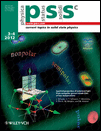Simulation of AlGaN and BGaN metal-semiconductor-metal ultraviolet photodetectors
Abstract
In this report, we study, by means of numerical simulation, the impact of the active layer properties and device geometry on the performance of the “solar blind” UV MSM detector based on AlGaN and BGaN alloys. The parameters investigated, using the Silvaco Athena and Atlas tools, were: (i) the Schottky contact width and thickness; (ii) the ternary (AlGaN or BGaN) physical properties, including the active layer thickness, n-type doping concentration and traps density. We implement the physical models and the ternary material properties, taken from literature or, if not available (as for the new BGaN ternary), from the interpolation between the binary materials weighted by the mole fractions. We have found that: (i) the photocurrent is highly improved by optimizing the device geometry, in particular the Schottky contact semi-transparency (depending on the contact thickness and metal absorption spectrum) and width; (ii) the doping and traps highly impact the device spectral response, and, in particular, a compromise in the doping concentration must be reached in order to maximize the detector performances; (iii) the incorporation of a small amount of boron in the active layer improves the detector spectral response. These results give us a powerful tool in order to understand quantitatively the impact of elaboration and processing conditions on the photodetector characteristics and thus identify the key issues in technology development (© 2012 WILEY-VCH Verlag GmbH & Co. KGaA, Weinheim)




